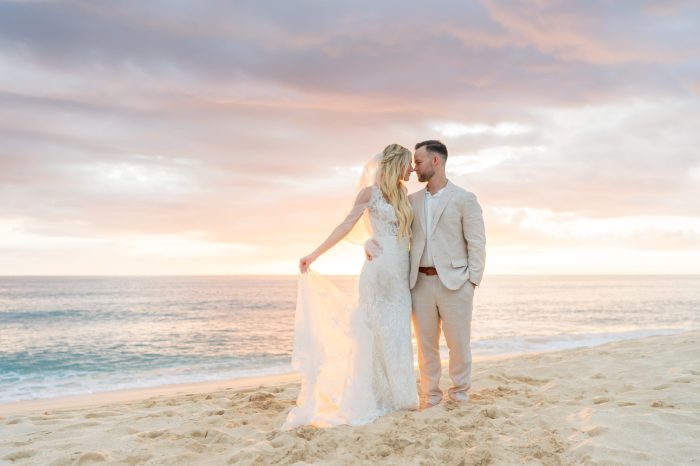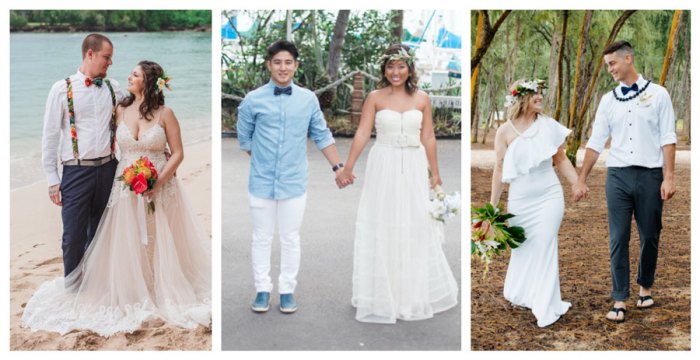Hawaiian Style Wedding Dresses A Guide
Defining “Hawaiian Style” in Wedding Dresses
Hawaiian style wedding dresses – Hawaiian-style wedding dresses evoke the spirit of the islands, blending romance with a relaxed, tropical elegance. They are characterized by a unique combination of fabrics, silhouettes, and design elements that reflect the rich culture and natural beauty of Hawaii.
Key Elements of Hawaiian Wedding Dresses
Several key elements define a Hawaiian-style wedding dress. These include the use of lightweight, breathable fabrics like silk, cotton, and linen, often adorned with traditional Hawaiian floral motifs. Silhouettes tend to be flowing and relaxed, emphasizing comfort and movement. Common designs incorporate elements such as off-the-shoulder necklines, delicate lace details, and intricate embroidery. These dresses often differ significantly from traditional Western bridal gowns, which frequently feature more structured silhouettes and heavier fabrics.
Common Fabrics in Hawaiian Wedding Dresses
The fabrics chosen for Hawaiian wedding dresses reflect the tropical climate. Lightweight silks, such as charmeuse and habotai, offer a luxurious feel and drape beautifully. Cotton and linen provide breathability and comfort, ideal for outdoor ceremonies. Some designers also incorporate locally sourced materials such as kapa cloth, a traditional Hawaiian bark cloth, for a truly authentic touch.
Silhouettes and Designs of Hawaiian Wedding Dresses
Hawaiian wedding dresses often feature flowing A-line or empire waist silhouettes that flatter various body types. Bohemian styles with intricate lace details and flowing skirts are popular choices. Many dresses incorporate off-the-shoulder necklines or sleeveless designs, allowing for a breezy and relaxed feel. The incorporation of traditional Hawaiian motifs, such as hibiscus flowers or plumeria blossoms, adds a unique cultural element.
Comparison with Other Bridal Gown Styles
Unlike the structured ball gowns or mermaid styles common in Western weddings, Hawaiian wedding dresses prioritize comfort and a relaxed elegance. They tend to be less formal and more adaptable to various settings, from beach ceremonies to garden receptions. The emphasis on natural fabrics and flowing silhouettes creates a distinct contrast to the often more elaborate and structured designs found in other bridal styles.
Color Palettes and Floral Motifs
The color palettes and floral motifs used in Hawaiian wedding dresses draw inspiration from the vibrant natural landscape of the islands. These elements contribute significantly to the overall aesthetic, reflecting the beauty and cultural significance of the location.
Hawaiian Wedding Dress Color Palettes

Source: simpleoahuwedding.com
Three distinct color palettes exemplify the diverse beauty of Hawaii:
- Tropical Sunset: Blending shades of coral, orange, and soft pink, inspired by the breathtaking Hawaiian sunsets. This palette evokes warmth and romance.
- Ocean Breeze: A cool palette of aquamarine, turquoise, and soft white, reflecting the serene beauty of the ocean. This palette creates a feeling of tranquility and peace.
- Lush Jungle: A vibrant palette featuring deep greens, rich browns, and pops of bright hibiscus red, reminiscent of the island’s lush vegetation. This palette conveys vibrancy and energy.
Incorporation of Traditional Hawaiian Floral Motifs
Traditional Hawaiian floral motifs are often intricately embroidered or appliqued onto the dresses. Hibiscus flowers, plumeria blossoms, and orchids are commonly used, each carrying symbolic meaning. These motifs can be subtly incorporated into the design or serve as prominent features, adding a touch of cultural authenticity and beauty.
Hawaiian Flowers and Their Symbolic Meanings
| Flower Name | Meaning | Color | Usage in Dress Design |
|---|---|---|---|
| Hibiscus | Delicate beauty, love | Red, pink, yellow, orange | Embroidery, appliqué, print |
| Plumeria | New beginnings, purity | White, yellow, pink | Lace patterns, subtle embroidery |
| Orchid | Long life, beauty | Purple, white, pink | Delicate embellishments, 3D floral accents |
| Bird of Paradise | Joy, paradise | Orange, blue | Embroidery, unique pattern design |
Accessories and Details
Accessories play a crucial role in completing the look of a Hawaiian wedding dress. They should complement the overall style while adding a touch of island flair.
Headpieces and Jewelry
Delicate flower crowns, made with fresh or artificial flowers, are popular headpieces. Simple, elegant jewelry made from natural materials like shells or pearls adds a touch of sophistication. Avoid overly elaborate pieces; keep the accessories understated to let the dress be the star.
Leis and Floral Accents
Leis are an essential part of Hawaiian culture and can be incorporated as beautiful accessories. A traditional lei made of fragrant flowers adds a touch of authenticity and fragrance. Other floral accents, such as smaller flower arrangements or boutonnieres, can complement the overall aesthetic.
Footwear
Footwear should be comfortable and appropriate for the setting. Barefoot elegance is a popular choice for beach weddings. For other venues, simple sandals or wedges in natural colors and materials complement the relaxed elegance of a Hawaiian wedding dress.
Accessory Options and Style Matches

Source: wedhawaii.com
| Accessory Type | Description | Material | Style Match |
|---|---|---|---|
| Flower Crown | Delicate headpiece of fresh or artificial flowers | Flowers, wire | Bohemian, Romantic |
| Shell Necklace | Simple necklace made of natural shells | Seashells, string | Beachy, Relaxed |
| Pearl Earrings | Elegant earrings made of pearls | Pearls, metal | Classic, Elegant |
| Floral Boutonniere | Small flower arrangement for the groom or bridal party | Flowers, ribbon | All styles |
Fabric and Construction Techniques
The choice of fabric and construction techniques significantly impact the overall look, feel, and durability of a Hawaiian wedding dress. Understanding these aspects helps in making informed decisions.
Properties of Fabrics Used
Silk offers a luxurious drape and sheen, while cotton and linen provide breathability and comfort. The choice depends on the desired level of formality and the weather conditions. Kapa cloth, a traditional Hawaiian bark cloth, adds a unique cultural element but requires careful handling.
Construction Techniques
Common construction techniques include hand-stitching, which can be used to create intricate embroidery or appliqué work, reflecting traditional Hawaiian craftsmanship. Modern techniques, such as machine embroidery and laser cutting, can also be incorporated for efficiency and intricate detail.
Durability and Care Requirements
Silk requires delicate care, while cotton and linen are more durable and easy to maintain. Kapa cloth is fragile and needs special handling. Understanding these differences is crucial for preserving the dress’s longevity.
Pros and Cons of Fabric Choices
- Silk: Pros: Luxurious drape, sheen; Cons: Delicate, requires special care, expensive.
- Cotton: Pros: Breathable, comfortable, durable; Cons: Can wrinkle easily, less luxurious feel.
- Linen: Pros: Breathable, durable, sustainable; Cons: Can wrinkle easily, less flowy than silk.
- Kapa Cloth: Pros: Unique cultural significance; Cons: Fragile, requires special care, limited availability.
Modern Interpretations of Traditional Styles
Modern designers are incorporating contemporary elements into traditional Hawaiian wedding dress styles, creating unique and stylish designs that maintain cultural relevance.
Modern Design Elements in Hawaiian Wedding Dresses
Modern interpretations often feature sleek lines, minimalist designs, and unexpected fabric combinations. Asymmetrical cuts, unconventional necklines, and the incorporation of modern embellishments are common. These elements add a contemporary edge while retaining the essence of traditional Hawaiian style.
Contemporary Hawaiian Wedding Dresses
Contemporary designs might feature a simple A-line silhouette in a lightweight linen, adorned with subtle hibiscus embroidery, or a flowing maxi dress in a vibrant print inspired by Hawaiian flora. These designs strike a balance between tradition and modernity, reflecting both cultural heritage and contemporary fashion trends.
Balance Between Tradition and Modernity
The key lies in carefully selecting modern elements that complement rather than overshadow the traditional aspects. Subtle incorporation of contemporary details, such as a unique neckline or unexpected fabric combination, can create a fresh and modern interpretation without losing the cultural significance.
Modern Design Elements and Their Effects
- Asymmetrical Necklines: Adds a modern twist to a traditional silhouette.
- Sleek Silhouettes: Creates a more contemporary and minimalist look.
- Unexpected Fabric Combinations: Introduces texture and visual interest.
- Minimalist Embellishments: Allows the fabric and silhouette to take center stage.
Illustrative Examples of Hawaiian Wedding Dresses: Hawaiian Style Wedding Dresses
Three distinct Hawaiian wedding dresses exemplify the range of styles and designs available.
Dress 1: The Hibiscus Dream
Imagine a flowing A-line gown crafted from ivory silk charmeuse. Delicate hibiscus blossoms, meticulously embroidered in shades of coral and pale pink, cascade down the skirt. The off-the-shoulder neckline softens the overall aesthetic, while a simple sash ties the waist, accentuating the bride’s figure. This dress embodies romantic elegance with a touch of traditional Hawaiian charm.
Dress 2: The Ocean’s Embrace
Picture a breezy maxi dress made from lightweight linen in a soft aquamarine hue. The simple, flowing silhouette is enhanced by subtle pleating at the bodice. Delicate plumeria blossoms, delicately embroidered in shades of white and pale yellow, adorn the neckline and shoulders. This dress evokes the serene beauty of the ocean, emphasizing simplicity and comfort.
Dress 3: The Lush Garden, Hawaiian style wedding dresses
Envision a vibrant gown crafted from a rich, deep green silk. Intricate embroidery depicting a lush tropical garden, featuring hibiscus, orchids, and bird of paradise flowers in various bright hues, covers the bodice and trails down the skirt. The dress features a fitted bodice and a full, flowing skirt, combining a modern silhouette with traditional Hawaiian motifs. This dress showcases the vibrancy and energy of the island’s lush landscapes.
Comparison of the Three Dresses
While each dress is unique, they share a common thread: a focus on lightweight, flowing fabrics and the incorporation of traditional Hawaiian floral motifs. They differ in silhouette, color palette, and the level of embellishment, offering a range of styles to suit different tastes and preferences.
Essential Questionnaire
What is the average price range for a Hawaiian style wedding dress?
The price varies greatly depending on the designer, fabric, embellishments, and level of customization. Expect a range from a few hundred dollars for simpler styles to several thousand for bespoke, high-end designs.
Where can I find Hawaiian style wedding dresses for sale?
You can find them at bridal boutiques specializing in unique or destination wedding attire, online retailers specializing in bridal wear, and even some independent designers who create custom gowns.
Can I incorporate my own cultural heritage into a Hawaiian style wedding dress?
Absolutely! Many brides blend elements from their own background with Hawaiian design elements to create a truly personalized and meaningful gown.
How do I care for a Hawaiian style wedding dress after the wedding?
Care instructions will vary depending on the fabric. It’s best to follow the care instructions provided by the designer or dry cleaner. Professional cleaning is often recommended for preservation.
















